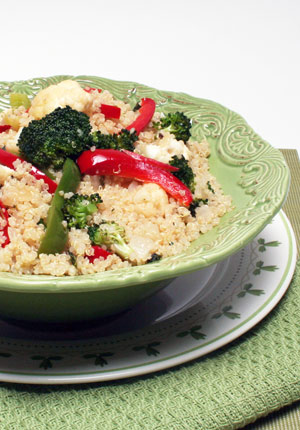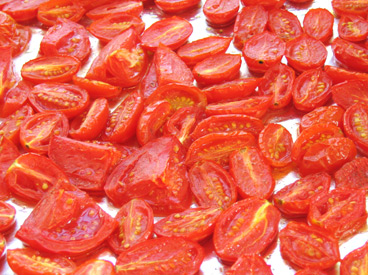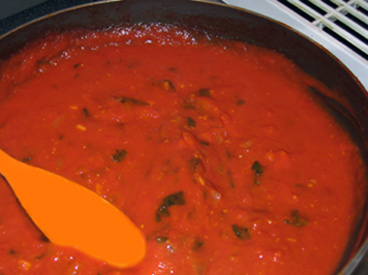Quinoa with Cauliflower and Broccoli
Cauliflower and broccoli are cruciferous vegetables, which contain cancer protective glucosinolates such as indoles and isothiocyanates. Their four-petal flowers (in the shape of a cross or crucifer) are also good sources of vitamin C and the B vitamin folate. And the colorful bell peppers add their own nourishing goodness of vitamin C.
Make it a meal: Serve this dish by itself or add a portion of roasted chicken. Or a cucumber salad: Dice fresh cucumbers and thinly slice some onions. Add a few tomato wedges and top with a bit of extra virgin olive oil and freshly squeezed lemon juice. Just like that, lunch or dinner is served.
Quinoa with Cauliflower and Broccoli
(Makes 8 servings)
Ingredients
- 1 tablespoon extra virgin olive oil, divided
- 2 cups cauliflower florets
- 2 cups broccoli florets
- 1 medium green bell pepper, sliced into strips
- 1 medium red bell pepper, sliced into strips
- 1 cup chopped onion, divided
- 3 cloves garlic, minced
- 1 tablespoon fresh thyme, chopped medium (1 teaspoon dried may be substituted)
- 1 tablespoon fresh oregano, chopped medium (1 teaspoon dried may be substituted)
- 1 cup quinoa
- 2 cups reduced-sodium vegetable broth
- Salt and freshly ground black pepper
Directions
- In skillet, heat 2 teaspoons olive oil over medium-high heat. Add cauliflower, broccoli, peppers, ½ cup onion, and garlic. Sauté 5 minutes until vegetables start to soften. Stir in herbs and sauté 2 minutes. Remove from stovetop and set aside.
- In strainer, place quinoa and rinse thoroughly with cold water. Using your hand, swish quinoa under running water for 2 minutes to remove bitter natural coating. Drain and set aside.
- In medium saucepan, heat remaining teaspoon oil over medium-high heat. Add remaining onion. Sauté about 3 to 4 minutes. Add broth and quinoa. Increase heat to bring mixture to boil. Reduce heat to medium-low, cover, and simmer until quinoa is tender, about 20 minutes.
- Gently stir in vegetable mixture and combine well with quinoa. Season with salt and pepper to taste. Serve.
Nutrition Facts
Per serving
Calories: 120
Total fat: 3.5 g
Saturated fat: 0 g
Carbohydrate: 20 g
Fiber: 4 g
Protein: 5 g
Sodium: 50 mg
Forever-Fit Garden-Fresh Marinara
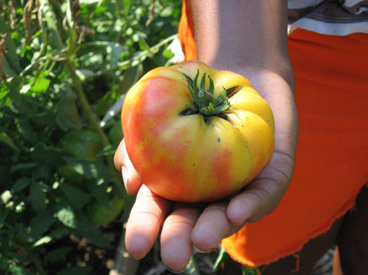
are truly a labor of love.
Tomatoes grow and ripen in the sun and on the vine in backyards, front yards, side yards, roofs, patios, and porches in countless cities, towns, and suburbs all across America. But what makes homegrown tomatoes so different (dare I say superior?) in taste and appearance than the store-bought varieties?
Small-scale garden and farm tomatoes are tended to by dedicated cultivators who provide the months of thoughtful attention it takes for these beguiling fruits to ripen to their fullest potential. And because they’re grown near or in the area you live, locally grown produce doesn’t have to commute across the continent, arriving pale and tasting weary on the plate of your already veggie-reluctant child or grandchild. It’s no wonder children aren’t eating their vegetables!
Forever-Fit Garden-Fresh Roasted Marinara Sauce
(Recipe yields 3 to 3.5 cups)
Ingredients
- 3 pounds of fresh Roma tomatoes (or your favorite garden variety), washed and cored
- Nonstick cooking spray
- 1 tablespoon extra-virgin olive oil
- 1 medium to large sweet onion such as Vidalia, finely chopped
- 2 to 4 cloves garlic, chopped
- ¼ cup extra virgin olive oil
- ¼ cup fresh oregano or 2 teaspoons dried
- ¼ to ½ cup fresh basil or 2 to 3 teaspoons dried
- ½ cup filtered water
- Course salt and pepper to taste
- ½ to 1 teaspoon granulated sugar if desired*
Directions
The flavor and texture of tomato sauce tends to be deeply personal, so this recipe leaves room for your own adaptions and variations based on your taste preferences. If you like more garlic—add more. Feel like thyme would be good? Go for it! Cooking is about experimentation and fun. Enjoy by sharing the experience with your loved ones, and cook with children whenever possible!
- Preheat oven to 350°F.
- With a sharp knife, halve tomatoes lengthwise. Divide tomatoes between two foil-lined baking sheets coated with nonstick cooking spray. Arrange in single layer, cut side up. Brush or drizzle 1 tablespoon of extra virgin olive oil over tomatoes. Season with salt and pepper. Roast 1 to 1½ hours (oven cooking times can vary).
- Remove pans from oven. Allow to cool for 15 to 20 minutes. Spoon tomatoes into food mill** set over large mixing bowl, and pass tomatoes through food mill using medium texture blade to puree. If smoother texture is desired, run through food mill a second time.
- Heat ¼ cup oil in saucepan over medium-high heat. Add onion, garlic, oregano, and basil. Saute for 5 to 8 minutes or until onion is translucent and tender. Add tomato puree and water or chicken broth. Bring to a boil, stirring to blend. Reduce heat to medium-low. Allow sauce to simmer, stirring frequently, until sauce has reached desired thickness (about 3 to 5 minutes). Season with salt and pepper to taste.
*If you find the taste to be too acidic or bitter (this can differ depending on type or freshness of tomato), adding a small amount of sugar can balance the acidity.
**If you don’t have a food mill, puree the tomatoes in a blender or food processor and strain through a sieve. If you don’t mind the unobtrusive seeds, you can skip the sieve entirely.
Nutrition Facts Per Serving
“Serving size: ½ cup”
Calories: 150
Total fat: 10 g
Saturated fat: 1.7 g
Carbohydrate:
Fiber: 3 g
Protein: 2.2 g
Sodium: 12 mg
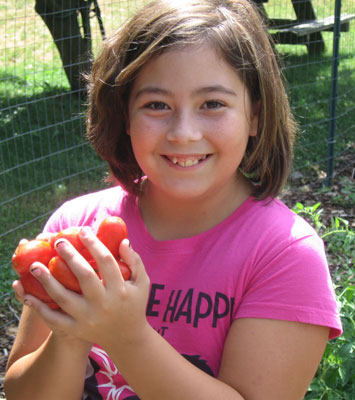
Have an over abundance of late harvest tomatoes or other garden produce? Visit the National Center for Home Food Preservation’s website for the most current, research-based methods for home-food preservation including: canning, freezing, drying, pickling, smoking, and curing, as well as important food safety considerations unique to the process of preserving and storing food in your home.
